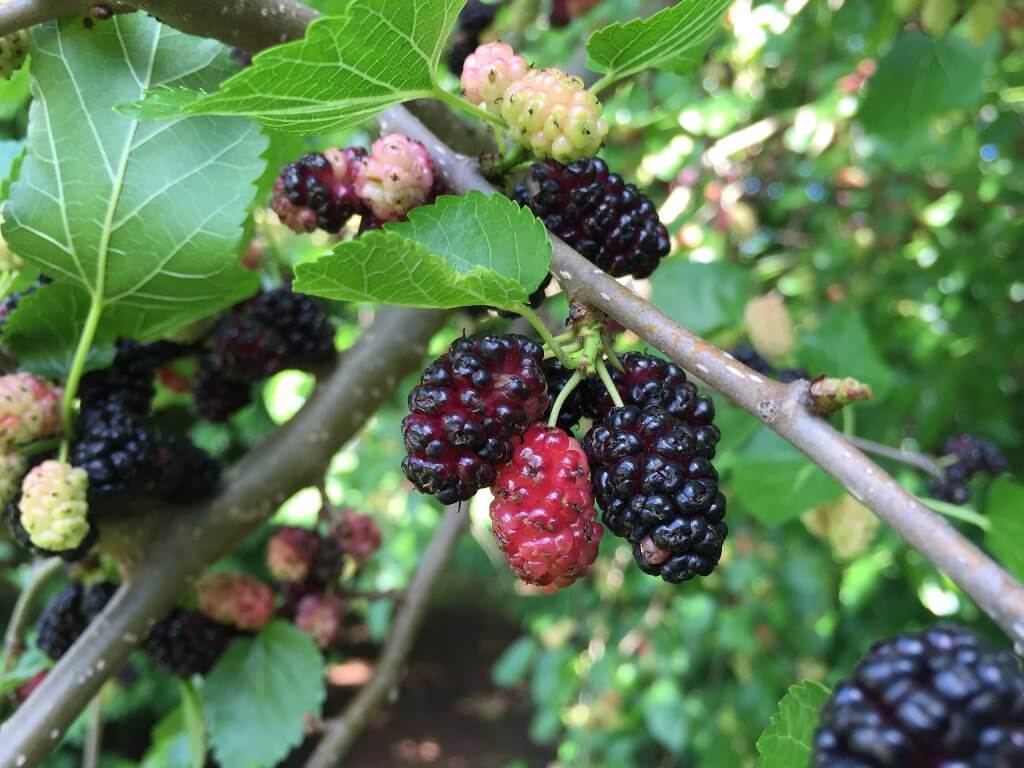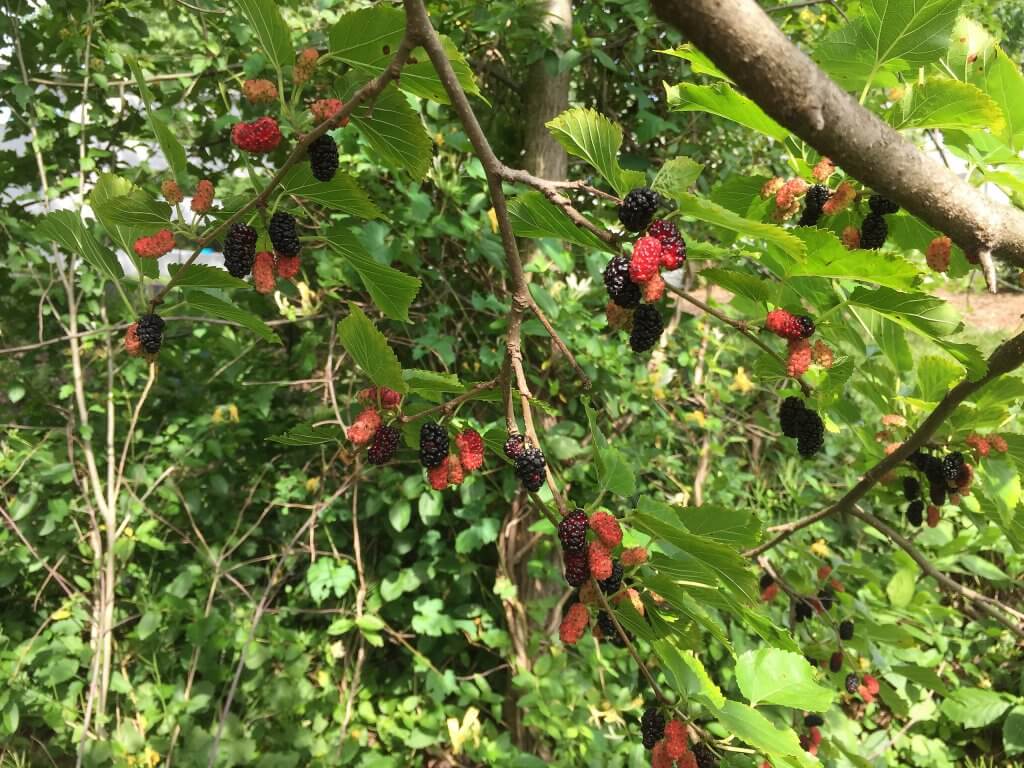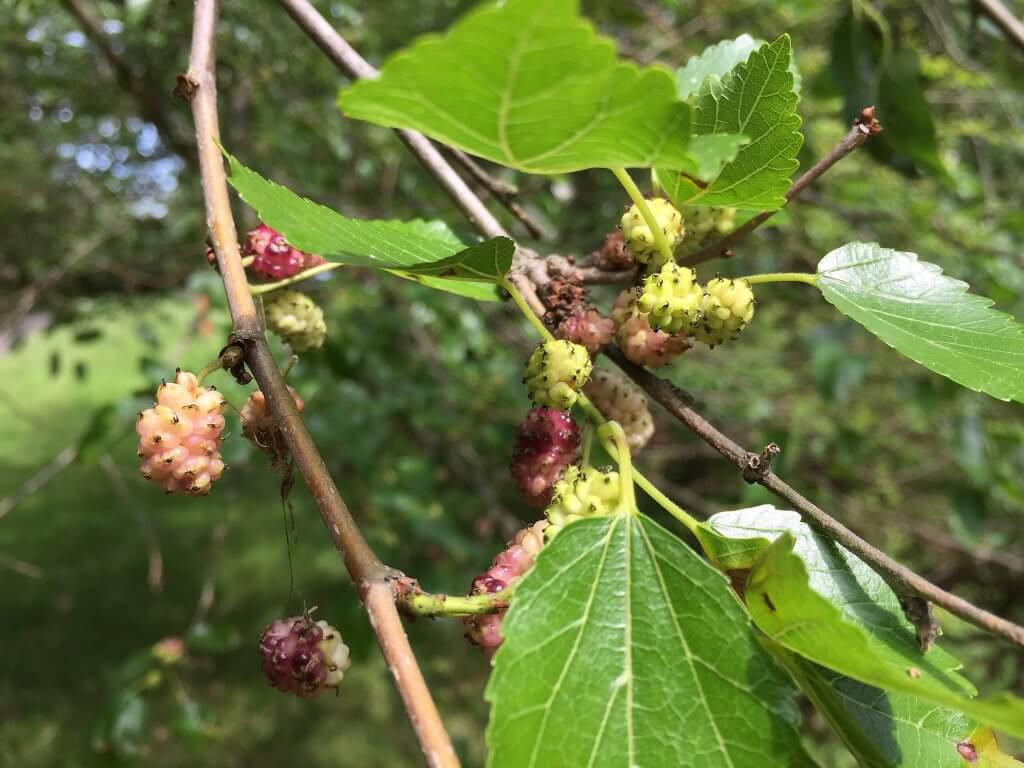Mulberry (Morus spp.), is a commonly occurring tree found across the states. Mulberries feature in a number of nursery rhymes some of us may remember from childhood. Particularly the “Here We Go Round the Mulberry Bush” rhyme.
Once a popular food source during colonial times, as time passed, other berries and exotic fruits captured our attention. This means the succulent berries are often underappreciated and are now only thought of as a nuisance because of their driveway-staining berries. However, foragers are starting to change this mindset, as they bring awareness back to these nutritious and delicious fruits.
Red, black, or white mulberries
Most species are native to Asia, including black mulberries (Morus nigra) and white mulberries (Morus alba). However, the red mulberry (Morus rubra) is native to North America. Through trading and colonization, white and black mulberries have now spread throughout other continents, including North America, Africa, and Europe.

Mulberries are deciduous trees, growing to heights of up to 20m. The two native species within the US include the red mulberry (Morus rubra) and the Texas mulberry (Morus celtidifolia). The red mulberry is largely found in the midwest and eastern states, with the Texas mulberry residing in the southwestern states and South America.
Another common find throughout all states is the introduced and invasive white mulberry (Morus alba) from China. They were introduced primarily as a cultivated crop, grown for their leaves which are used to feed silkworms.
On young trees, you will likely come across large, lobed leaves with the more simple leaves developing as the tree matures. Each leaf has a lightly serrated margin and is alternately arranged along the branches. As the fruits begin to develop from the subtle white flowers in early summer, the tree should become instantly recognizable. The plump fruits greatly resemble an elongated blackberry.
Edible parts and other uses
The sweet-tasting berries can be baked into pies, cobbler, cakes, and an array of desserts. Jams, smoothies, liquors, and a number of experimental savory cuisines are also popular creations for wild foragers and top chefs alike.
Native Americans widely used mulberries within their cuisines, whether eaten raw, boiled, or dried. They also utilized the wood and inner bark of the tree, using it to smoke meats and even weave clothing from the tender inner bark.
From the extensive silk industry to dried supplements in health stores. Mulberry trees have a diverse range of uses. Scientists have also begun to study the possibility of using mulberries as a source of natural food dye due to their strong coloring.

Cautions
The fruits of the mulberry tree are very unique, so misidentification should not be an issue. However, as a wild berry, a level of care is still needed.
The unripened fruit and any green part of the plant should not be consumed. Studies have shown that some mildly toxic compounds may exist within the sap.
Foraging
Mulberries usually start ripening in early summer, from June onwards. Depending on your location they may start a little later in more northerly states.
When distinguishing between species, the leaves are a good indicator as to which species you have before you. Red mulberry leaves are the largest (approx. 10-15cm) and with a rough upper texture and fine hairs on the underside. The white mulberry leaves are smaller (approx. 5-10cm) and have a glossier coating. The less common Texas mulberry has the smallest leaves, generally reaching no more than 7cm long.

In the wild, look for them in areas of moist but well-draining soils, particularly in areas close to rivers and streams.
Mulberries should loosen easily from the branches when plucked, so if you have to tug to remove them they aren’t quite ready yet. One of the best methods for harvesting the berries is to lay down a sheet (that you don’t mind being stained!) and give the tree a few sharp shakes.
All ripened berries should easily fall down onto the sheet, making for an easier collection.
Did you know…
A popular ornamental tree, they can often be found growing in urban and suburban areas. Male trees were favored, because of their inability to form the sidewalk-staining fruits.
However, it was recently discovered that the male trees produced a lightweight and potent pollen that greatly affects hay fever and even asthma sufferers. Because of this, new plantings in urban areas are likely to be female trees.
Conclusion
High in vitamin C and in abundance, mulberries are a fantastic wild summer berry to forage. As a crop, you are unlikely to find mulberries in a supermarket as they are easily bruised in transport. This makes them all the more rare and sweet when foraging for your own supply.
They’re a great, unusual fruit to grow in your own garden too. You can usually find some cultivated varieties in specialist online nurseries. You could even try growing your own mulberries from seeds collected from the wild. Just note that white mulberries are considered invasive. Foraging them is encouraged, but growing wild seeds is not.
The berries are a firm favorite for wildlife too, so you may need to frequently check your local tree to ensure you have a chance to make a harvest before the berries quickly disappear!
—————Written by Hannah Sweet
Hannah is a freelance writer and graphic designer from the UK. With a penchant for travelling, photography and all things botanical, she enjoys writing about a wealth of topics and issues, from conservation and slow living, to design and travel. Learn more about her writing and design services at www.sweetmeanders.co
Many of our readers find that subscribing to Eat The Planet is the best way to make sure they don't miss any of our valuable information about wild edibles.
See our privacy policy for more information about ads on this site







3 Responses
I have a female mulberry tree. How can I get a male mulberry tree and do I need one for the female tree to produce an abundance of berries? This article was excellent information. Thank you.
BJ From what I understand mulberry trees can either be dioecious, or monoecious and can change during their lifetime. If you have a female tree its likely that it will become monoecious and self pollinate. If you’ve gotten any berries from the tree then either there is another tree nearby or this tree has produced some male flowers.
I have one of these trees, my Dad started it many years ago but he told me it was an apple tree where he had started on his own from apple seeds..now I’m confused